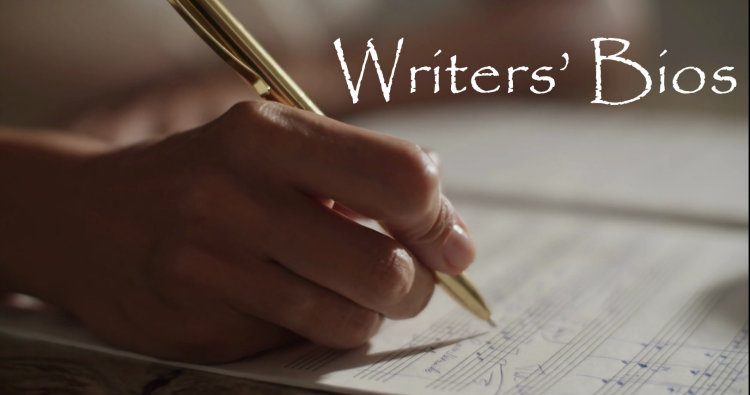GO TO: [A–C] [D–F] [G–K] [L–N] [O–R] [S–U] [V–Z]
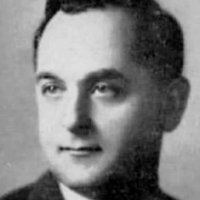
Regarded as one of the top American songwriters of the 1920s and 1930s, Ager is best remembered for his 1929 song "Happy days are here again" which he wrote in collaboration with Jack Yellen, with whom he founded a publishing company to promote their work. 6.
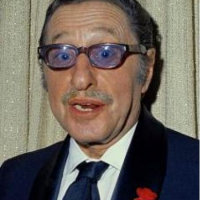
Born in Buffalo (as Hyman Arluck), the son of a cantor, he formed a band as a teenager then moved to New York City to work in vaudeville. In the 1930, he was working mainly with lyricist Ted Koehler, producing standards such as "Let's fall in love" and "Stormy weather." In 1935, however, he signed with MGM and began writing songs for movies, mostly with Yip Harburg, including the iconic score for The Wizard of Oz (1939). 6.
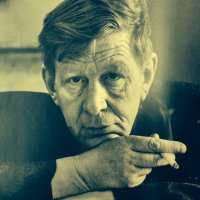
After an early career in England, tackling subjects from romance to religion, Auden moved to America in 1939. Always a lyric poet of considerable technical sophistication, his later career is noted for his opera libretti, including that for Stravinsky's Rake's Progress. 1.
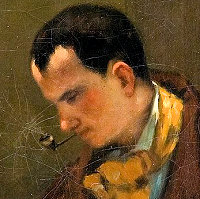
Baudelaire is credited with coining the term "modernism," and is held to be the first modernist poet. His masterpiece, the Les fleurs du mal (The Flowers of Evil), which hovers between sensual verse and an exotic kind of prose, was prosecuted as an offence to public morals, and the author was fined. Baudelaire was nonethless a great influence on the next generation of poets, like Verlaine, Rimbaud, and Mallarmé. 1.
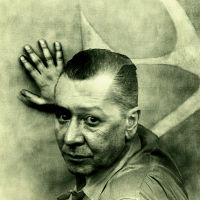
Baziotes was born in Pittsburgh to Greek parents, and studied art in New York. He became friends with many of the Abstract Expressionist painters, but his own work is equally influenced by the European Surrealism of Miró and Arp, featuring an interplay of biomorphic shapes on an indeterminate ground. 5.
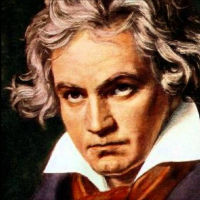
The dominant composer of his time, Beethoven wrote 9 symphonies, 16 string quartets, 32 piano sonatas, and one opera, Fidelio, which he labored on in several versions between 1805 and 1814. From about 1800 onwards, increasing deafness gradually put an end to his performing career, although he wrote some of his finest works when totally deaf. He is one of the first composers to exhibit a distinct late style. 5.
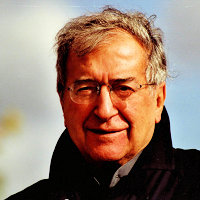
After following a practice of strict serialism for some years, Berio began to depart from it by including elements of chance and collage, incorporating fragments of other works as in his Sinfonia (1969), arguably his masterpiece. His Folk Songs of 1975 was one of several works written for his wife, the American soprano Cathy Berberian. 3.
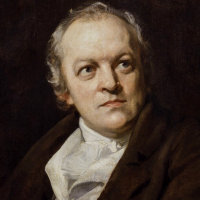
His work spans the late classical and early romantic periods, but his style in each of his many media is sui generis and infused with a strongly mystical bent. 1, 4.
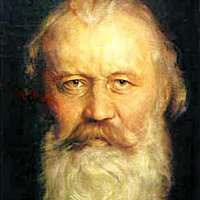
Although writing music whose harmonies and colors eiptomized the Romantic age, Brahms was a classicist at heart, developing the traditional forms of symphony, sonata, quartet and so on, and avoiding program music and opera. A master of virtually every genre, he is often listed together with Bach and Beethoven as the third of the "Great Bs." 5.
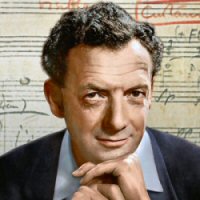
Arguably the leading opera composer of the mid-20th century, Britten's major operas have included Peter Grimes (1945), Billy Budd (1951), Gloriana (1953), A Midsummer Night's Dream (1960), and Death in Venice (1973), plus many stage works for smaller forces. He was equally active as a composer of instrumental music and text settings, and latterly as a conductor and accompanist. 1, 3, 4.
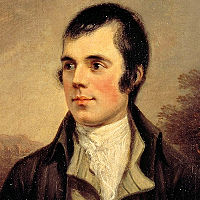
Rabbie Burns is often regarded as the national poet of Scotland, where his birthday (1/25) is an occasion for the often-drunken singing of his many songs. His manner as "peasant-poet" was largely assumed; he was in fact quite well educated, and held his own with other figures of the Scottish Enlightenment. He wrote mainly in a Scottish dialect, but it is mostly intelligible to non-Scots. 3.
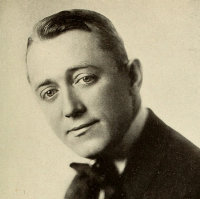
Although his stage film and career lasted until his death, Cohan established himself before WW1 as "the Man Who Owned Broadway." Starting as a child performing with his parents and sister, he wrote hundreds of Tin Pan Alley songs and several musicals, starting with Little Johnny Jones in 1904. He was also active as an impresario, producing the work of others. He is played by James Cagney in the 1942 biopic Yankee Doodle Dandy. 6.
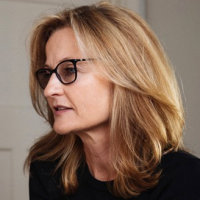
Cooper has written music for films, television, and stage plays, in addition to concert music. Her most recent album is Continuum (2022), a kind of musical diary of life under lockdown. 5.
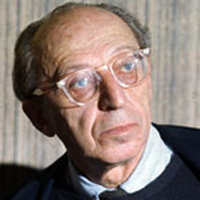
Trained in Paris, Copland began writing in the style of the European avant garde, but in his ballet commissions in the 1930s and 1940s, such as Billy the Kid, Rodeo, and Appalachian Spring, he developed the open folk-inflected style that has become, for many people, the sound of American music. 4.
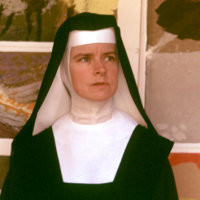
Born in Iowa, Frances Elizabeth Kent entered the Californian Sisters of the Immaculate Heart at age 18, and took the name Sister Mary Corita. The order was known for its liberalism and respect for creativity, and Sister Corita flourished, teaching herself silk-screen printing and eventually becoming head of the college art department. But her increasing social activism set her at odds with her Cardinal, and she left the order in 1968 to continue her work on the East Coast under the name Corita Kent. 3.
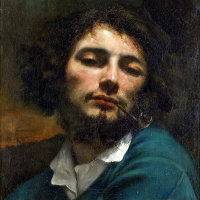
A fiercely realist painter from the provinces who stood proudly outside the academic tradition, Courbet was nonetheless one of the most powerful figures in 19th-century French art. His vast Burial at Ornans was a succès de scandale at the Salon of 1850, and established him as the leader of the Realist movement. 1.
GO TO: [A–C] [D–F] [G–K] [L–N] [O–R] [S–U] [V–Z]
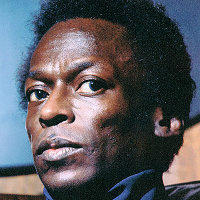
A trumpeter, bandleader, and composer, Davis had a career in jazz spanning five decades and numerous different styles. After playing with Charlie Parker 1944–48, he struck out on his own, leading groups that included such players as John Coltrane and Herbie Hancock. His Kind of Blue album of 1959 was performed almost entirely without written music, and became one of the best-selling jazz records of all time. 5.
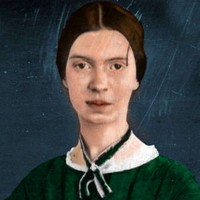
As she lived in Amherst for her entire life, latterly refusing to leave her family home, Dickinson's prolific output was virtually unpublished in her lifetime, and was subject to editing after her death to bring it more in tune with contemporary aesthetics. But it is precisely the unconventional nature of her verse, with its short lines and slant rhymes, that has led to her recognition as one of the leading American poets of her time. 4.
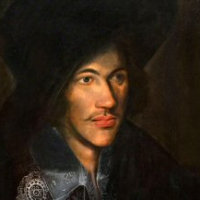
Though classed with the Metaphysical Poets of the early 17th century, he had an immense range, from erotic to sacred, characterized by an extraordinary intensity. He took holy orders later in life, and was appointed Dean of St Paul's Cathedral. 2.
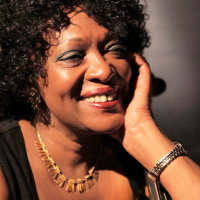
Dove is a Pulitzer Prize winner (1987) and a former Poet Laureate (1993–95). She teaches at the University of Virginia. Her work is wide-ranging and addresses a variety of themes, including the life of the Black violin prodigy George Bridgetower, the original dedicatee of Beethoven's Kreutzer Sonata, whose tragedy she explored in her 2009 book Sonata Mulattica, 5.
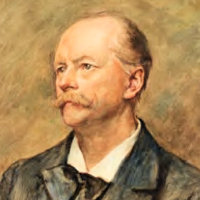
Duparc studied with César Franck, and established himself early on as a composer. However, a combination of nervous illness and deteriorating vision led him to abandon composition at the age of 37 and destroy much of his earlier work. He is best known for his small but exquisite set of songs. 1.
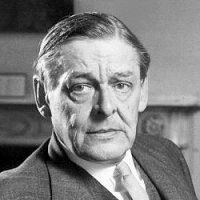
One of the leading modernist poets of the 20th century, known for works such as The Waste Land (1922) and Four Quartets (1936–42), Eliot also found success in the theatre with works such as Murder in the Cathedral (1935). His light verse collection Old Possum's Book of Practical Cats (1939) was the source for Andrew Lloyd Webber's Cats. 1, 4.

Bishop of Liège from 901 until 920, Étienne is credited with composing several sets of church music in Gregorian chant. 1.

Born in Monte Carlo, where his father was manager of the casino, and encouraged by Edith Piaf, Ferré became one of the leading singer-songwriters in France after WW2, performing both his own material and songs he composed to other texts, such as Baudelaire's Fleurs du mal. 1.
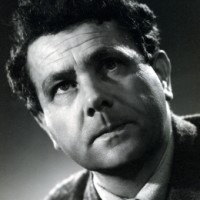
Although he composed in other genres, Finzi is best known for his vocal works, such as the cantata Dies Natalis (1939), his Shakespeare cycle Let Us Garlands Bring (1942), and many settings of Thomas Hardy. 4.
GO TO: [A–C] [D–F] [G–K] [L–N] [O–R] [S–U] [V–Z]
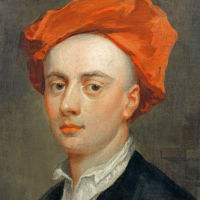
Although he wrote the libretto for Handel's early opera Acis and Galatea (1718), Gay is best known as the author of The Beggar's Opera (1728), satirizing the very kind of opera that Handel made famous. The songs in this piece about highwaymen and whores are sung to popular tunes arranged by the German-English composer Johann Pepusch. 3.
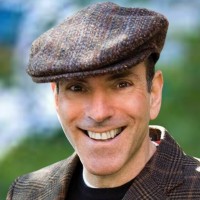
Gordon has written several stage works, both opera and musical theater, and numerous songs that have been performed by headline artists. 4.
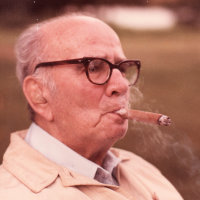
Born in Russia (as Abraham Jacob Gornetzsky), Gorney was brought to this country at the age of 10. After an education at the University of Michigan and WW1 service with the US Navy, he began work on Tin Pan Alley, collaborating frequently with Yip Harburg, including on his hit song "Borther, can you spare a dime?" 6.

After painting his extraordinary masterpiece, the multi-paneled Isenheim Altarpiece, in 1515, he faded from memory; his rediscovery as the most visionary artist of his era is fairly recent. "Grünewald" (Greenwood) is a nickname; his real name was Gothardt or Neithardt. 2.
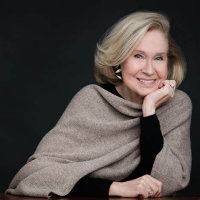
A graduate of Goucher College and for a time a sports writer for the Baltimore Sun, Hammond established herself as a poet in New York, where she taught for many years through the Writers' Workshop. 1.
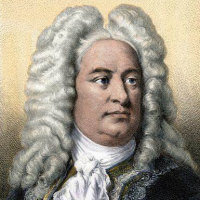
Gradually over the last half-century, Handel's 42 operas and numerous dramatic oratorios have been recognized as placing him on the level of Mozart and Verdi as an opera composer. The delay in appreciation is partly due to the fact that his preferred form, opera seria, is based almost entirely on recitative and solo arias. Born in Germany and trained in Italy, he dominated the English musical scene in the first half of the 18th century. 5.
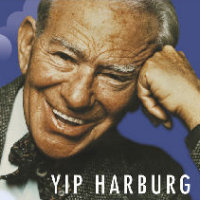
Born Isidore Hochberg, he later took the name Edgar Yipsel Harburg, the "Yipsel" being a nickname for members of the Young Peopl's Socialist League. His left-leaning politics may be seen in songs like "Brother, can you spare a dime?" which he wrote with Jay Gorney, although his most famous work—the song texts for The Wizard of Oz—have no such agenda. 6.
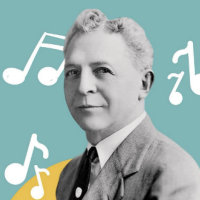
Harris's 1892 song "After the Ball" became a runaway success. He ploughed his huge profits into setting up his own business as a Tin Pan Alley publisher, writing over 300 songs, but none achieving the same sentimental appeal. 6.
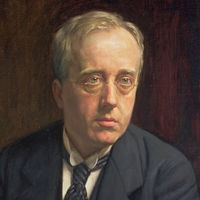
The son of a church organist of Swedish descent, Holst studied first the piano and then the trombone. With Ralph Vaughan Williams, he was largely responsible for the revival of interest in English folk music at the turn of the century. He worked most of his life as a church musician and in education, but wrote numerous works, of which The Planets (1918) is the largest and most famous. 3.
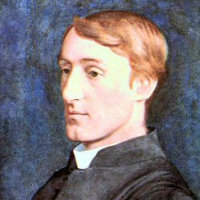
A Jesuit priest, his earlier poetry was concerned with the nature of God as manifested in Nature. Later in his career, he went on to explore the depths of his own soul in bleak depression. 2.
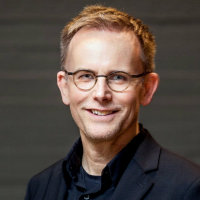
Born in Minnesota, Johnson has established himself as a leading composer and conductor of choral music. He directed the group Chanticleer before founding his own ensemble Conspirare in 1991. His recordings have been nominated for 8 Grammys. He adopted the middle name "Hella" in tribute to the Norwegian birthplace of his parents. 4.
GO TO: [A–C] [D–F] [G–K] [L–N] [O–R] [S–U] [V–Z]
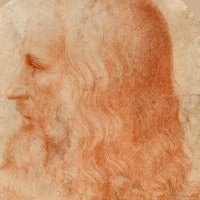
With Michelangelo and Raphael, one of the triumvirate of artistic geniuses that crown the High Renaissance. He trained in Florence with the painter Andrea Verrocchio before moving to the court of Ludovico Sforza in Milan. He spent the last years of his life at the court of François I in France. The naturalism and luminosity of his painting, and his effects of sfumato (or modeling as if by smoke), were widely influential. It is his notebooks, however, that are the best testament to the range of his genius, containing remarkable observations of the natural world, and mechanical inventions centuries before their time. 1.
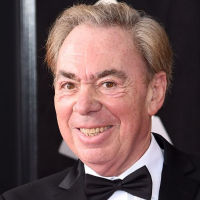
Baron Lloyd-Webber is credited with reinvigorating the stage musical with a series of hits that include Jesus Christ Superstar (1970), Evita (1976), CATS (1981), and The Phantom of the Opera (1986). He has also written a certain amount of non-theatrical music, including an anthem for the coronation of King Charles III. 4.
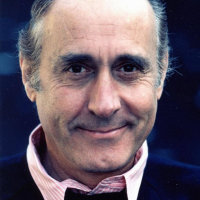
Born in Ohio to Italian immigrant parents, Mancini served in the US Air Force in WW2. There he met Glenn Miller, who later got him a job in Hollywood, thus launching a career as one of the most successful film composers in Hollywood history, winning four Oscars. His hits include the song "Moon River" in Breakfast at Tiffany's (1961) and the theme music to the Pink Panther series. 6.

Matisse and Picasso stand as the giant pillars of French art in the first half of the 20th century. Matisse was the slower starter and the less versatile, but he stands alone for the richness of his color and the sensuality of his forms, whether in painting or in sculpture. Suffering from crippling arthritis at the end of his life, he produced a completely new oeuvre in colored-paper collage. 1.
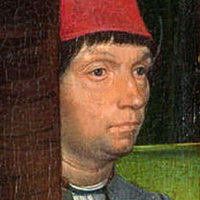
Based in Bruges, and probably a pupil of Rogier van der Weyden, he developed a sweeter more balanced version of his style which brought him great success. Also spelled "Memlinc." 2.
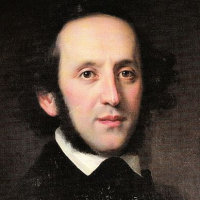
A major figure in the Romantic movement and a precocious talent, he wrote many of his best-known works (such as the Midsummer Night's Dream overture) while still in his teens. By virtue of his ten separate residencies in England or Scotland, and the works he premiered there, he almost qualifies as a virtual British composer. 5.
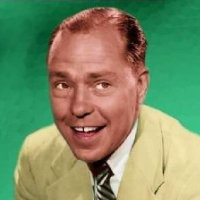
Born in a prosperous family in Savannah, Mercer took an early interest in black music and jazz. He had hoped to become a composer, but found that his greatest talent was as a lyricist. His over 500 songs include "Moon River" in Breakfast at Tiffany's (1961). He also had a parallel career as a singer, and was co-founder of Capitol Records. 6.
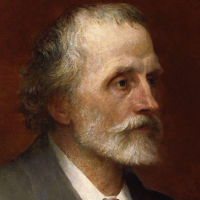
Meredith was a respected poet and relatively minor novelist of the Victorian era. His autobiographical sonnet squence Modern Love (1862), however, broke new ground in telling of the break-up of a marriage in psychologically realistic detail. 5.
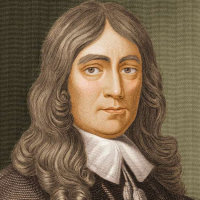
Milton's immense poem Paradise Lost (1667) is widely considered one of the masterpieces of English literature. He also wrote numerous shorter poetic works and a variety of political or philsophical pamphlets. At various times, he was also in government service. He was almost totally blind for his last two decades, and had to dictate his work. 5.
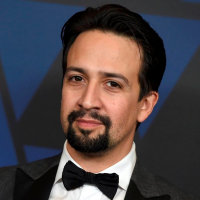
As the playwright, lyricist, composer, and star performer in his 2015 mega-hit Hamilton, Miranda became an unheard-of quadruple-threat on Broadway. He had shown many of the same talents, however, in his 2005 musical In the Heights, and has since developed his career further into film (both acting and directing). 1, 6.

Miró was one of the founding group of Surrealists in 1928, and continued to allow his work to be guided as far as possible by his unconscious mind. Avoiding the realism of his contemporary and compatriot Dalí, he preferred abstract forms, although these can often have a human reference. 1.

Both as leader of his own company since 1980 and in collaborations all over the world, Morris has created works noted for their expressivity, humor, and power to surprise. Morris is exceptional in his reponse to music of all periods, which had led him into opera directing and even to conducting. 5.

A child prodigy as both performer and composer, Mozart produced an extraordinary body of work in all genres over a relatively short life. He wrote the greatest of his many operas after moving to Vienna: three collaborations with Lorenzo da Ponte—The Marriage of Figaro (1786), Don Giovanni (1787), and Così fan tutte (1790)—framed by two German Singspiels: The Abduction from the Seraglio (1782) and The Magic Flute (1791). 1.
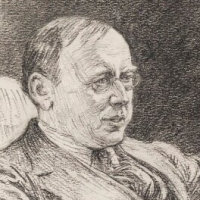
English schoolchildren know of Noyes from his poem "The Highwayman," but he had a varied career that included six volumes of verse, an epic trilogy The Torch Bearers, a play about Robin Hood, and nine years of teaching at Princeton. 2.
GO TO: [A–C] [D–F] [G–K] [L–N] [O–R] [S–U] [V–Z]

Writing both sacred and secular vocal music, he was one of the leading musicians of the late 15th century. 2.
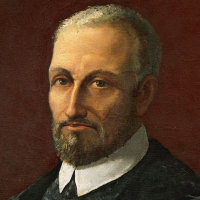
Born near Rome, he was active in Roman churches almost all his life, first as chorister and then as choirmaster. His large output was mainly of sacred music (for example, 105 masses) though he also wrote secular madrigals. His multi-voice contrapuntal style is considered the culmination of renaissance polyphony. 2.
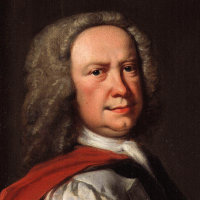
Johann Christian Pepusch grew up in Berlin. When still in his teens, he took up a position at the Prussian court, where his pupils included the future Frederick the Great. In 1698, he moved to Amsterdam and thence to London, where he led a long career as a teacher, conductor, and theater musician, in which capacity, he arranged the music for John Gay's Beggar's Opera (1728). 3.
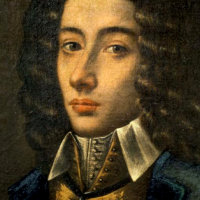
Although he died at the age of 26, Pergolesi had already written several operas, including the comedy La serva padrona, and a variety of religious music, most notably his Stabat Mater. His work is noted for its melodic grace and sweetness. More music is attributed to him than he could possibly have written! 2.
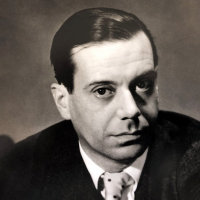
Unlike many Broadway composers, Porter wrote not only the music but the lyrics for his songs, and these are notable for their wit, clever rhyming, and encyclopedic range of reference. In addition to numerous standalone songs that became standards, he also wrote musicals such as Anything Goes (1934), Kiss Me, Kate (1948), and Can-Can (1953). 6.
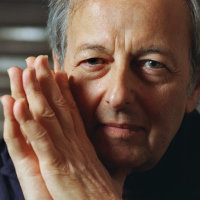
A multi-talented musician, Previn escaped Germany with his family in 1938 and traveled to California via Paris. Even as a teenager, he started composing music for MGM films, and eventually won four Oscars. Meanwhile, he was establishing himself as a jazz pianist. His career as a classical conductor played out in directorships in Houston, London, LA, Pittsburgh, and Oslo, with guest appearances all over the world. In later years, he put most of his energies into composition, writing the successful opera A Streetcar Named Desire (1998) and numerous other works. 4.
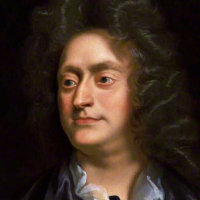
Not only was Purcell the greatest composer of the Restoration period, writing music for occasions ranging from a royal coronation to an opera to be performed in a girls' school (Dido and Aeneas), he was the last indisputably great English composer for almost three centuries. Among many other qualities, he is renowned for the rhythmic acuity of his settings of English texts. 2.

Reich's contribution to the minimalist movement was through his concept of "phase shifting," simple patterns which change perceptibly as one listens. His Music for 18 Musicians (1976) and Tehillim (1981) have become minimalist icons. His Different Trains (1988) for taped voices and string quartet, is a striking musical memorial to victims of the Holocaust. 2.

Roth's online biography is too good not to quote: "His work seeks the liberation of improvisation from composition, the poetic syntax of philosophical enquiry, and the function of music as translative epistemology." He has been honored by residencies all over Europe and the US. 4.
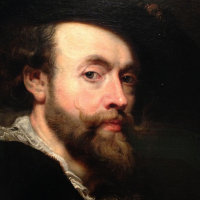
One of the giants of baroque art, Rubens developed the style of Titian into a powerful rhetoric applied equally to sacred and profane subjects, and exerted enormous influence in Spain, England, and France as well as in his native Flanders, continued in the work of his many pupils. His position at so many courts also made him invaluable as a diplomat. 2.
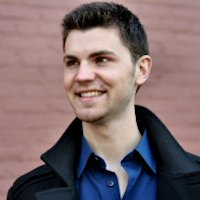
As a composition student at the Peabody Conservatory, Runestad wrote in many genres, including opera, but he has gone on to become one of the most successful composers writing for and inspired by the great choral tradition of the American Midwest. 2.
GO TO: [A–C] [D–F] [G–K] [L–N] [O–R] [S–U] [V–Z]
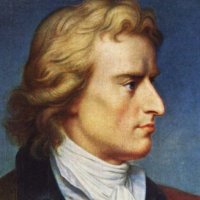
A close friend with Goethe, he was also a leading figure in "Weimar Classicism." His historical dramas such as Mary Stuart, Don Carlos, and William Tell became important sources for 19th-century operas. 5.
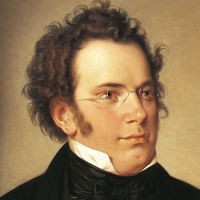
Although he died before his 32nd birthday, Schubert was extremely prolific as a composer, writing symphonies, masses, chamber music, piano sonatas, and over 600 songs, both individually and in cycles. Though little known in his lifetime, his work was rediscovered and championed by Mendelssohn, Liszt, and Brahms, making him in effect the source of the German Romantic movement. 4.
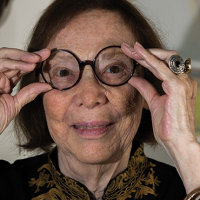
For 34 years, Schulman was poetry editor of The Nation. She is also a winner of the 2016 Frost Medal for Distinguished Lifetime Achievement in American Poetry, awarded by the Poetry Society of America, and a member of the American Academy of Arts and Letters. 5.
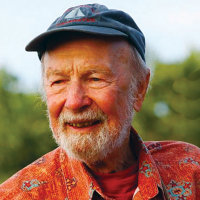
The son of musicians, Seeger first established himself in the classical world, for example by setting up the music department at UC Berkeley. But forced to resign in 1918 due to his outspoken pacifism, he gradually turned to folk music, emerging after WW2 as a prominent proponent of protest songs including "Where have all the flowers gone?" and "We shall overcome." 3.
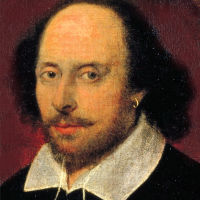
With almost 40 plays, 154 sonnets, and many longer poems, Shakespeare dominates English literature of his time, and world literature for ever after. To attempt a thumbnail biography would be both unnecessary and impossible. 4.
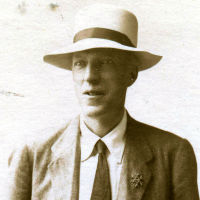
Sharp was the pre-eminent figure in the English folk-song revival in the early 20th century, collecting over 4,000 songs from untutored singers in SW England and the Appalachian Mountains in the US. Although he was also a composer, his more important musical legacy can be found in the inspiration he gave to other composers, such as Vaughan WIlliams, Holst, and Butterworth. 3.
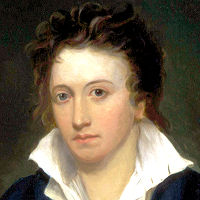
With his friend Byron, Shelley was the outstanding English Romantic poet of the generation after Wordsworth and Coleridge. Politically engaged, and intellectually acute, he was an avowed atheist, a stance that got him expelled from Oxford, and kept him out of England for much of his short career. He drowned in a boating accident off Livorno at the age of 29. His second wife, Mary Godwin Shelley, was the author of Frankenstein. 5.
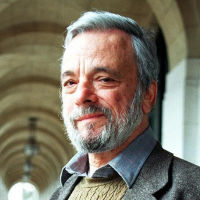
A protégé of Oscar Hammerstein's, Sondheim made his Boadway debut in 1957 as lyricist for West Side Story and Gypsy, but he soon began his own string of musicals, writing the music as well as the words, including A Funny Thing Happened on the Way to the Forum (1962), A Little Night Music (1973), and Sweeney Todd (1979). Often dealing with non-traditional subjects, these and others largely redefined the Broadway musical in the later 20th century. 6.
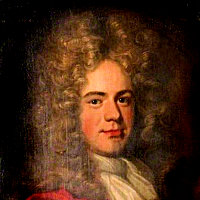
Tate is best remembered today as the librettist of Purcell's Dido and Aeneas and the author of "While Shepherds Watched their Flocks by Night." But he was one of the major playwrights of his day, and his Lear is one of the most notable attempts to reshape Shakespeare into a form acceptable on the Restoration stage. 2.
GO TO: [A–C] [D–F] [G–K] [L–N] [O–R] [S–U] [V–Z]

Although known as a poet, (for his WW1 poem La jeune Parque among others), Valéry's most abundant works were critical and philosophical essays in prose. He was also notable for the Cahiers or notebooks that he added to every day of his life. 1.
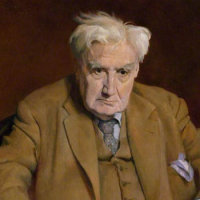
Associated with the English folk song revival, he was more than anybody responsible for giving English music its national voice. He wrote nine symphonies and numerous vocal works, including the one-act opera Riders to the Sea. His first name is pronounced "Rafe." 3, 5.
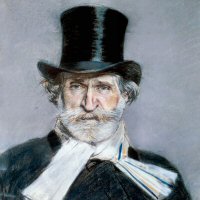
Verdi's two dozen or more operas (depending on how you count them) make him the leading Italian opera composer of his time and among the two or three greatest opera composers ever. After what he called his "years in the galleys," he hit his stride in the early 1850s with the trio of Rigoletto, Il Trovatore, and La Traviata. He intended Aïda (1870) to be his last work, but was persuaded out of retirement to write his final Shakespearean masterpieces: Otello (1886) and Falstaff (1893). 2.
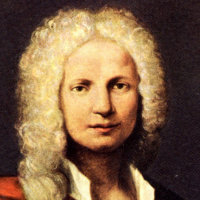
Vivaldi, who was ordained as a priest, but lived a largely secular life, was an amazingly prolific composer of music in most genres, including opera, oratorio, and the instrumental concerti on which his later fame mainly rests. 5.
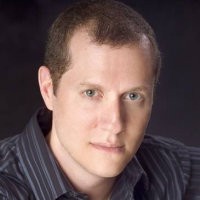
While still a student at the Peabody Conservatory, Weiser wrote the opera Where Angels Fear to Tread (2002) to an adaptation of the EM Forster novel by Roger Brunyate; this received its professional premiere by Opera San Jose in 2015. He has since gone on to write seven other operas and numerous orchestral and instrumental works. He teaches at the USC Thornton School of Music in Los Angeles. 4.
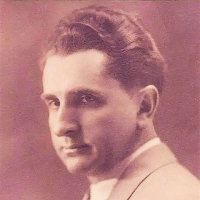
Born in Poland (as Jacek Selig Jelen), Yellen was brought to this country at the age of 5. He formed a publishing company with Milton Ager to pomote their songs, the best known of which is "Happy days are here again," written in 1929 but achieving fame when FDR adopted it as his campaign song in 1932. 6.
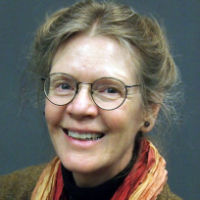
Zwicky has taught philosophy at Princeton and several Canadian universities, exploring the resonance between philosophical and poetic thinking. She is a musician herself, and her poetry is often inspired by music. She was appointed to the Order of Canada in 2022. 5.
